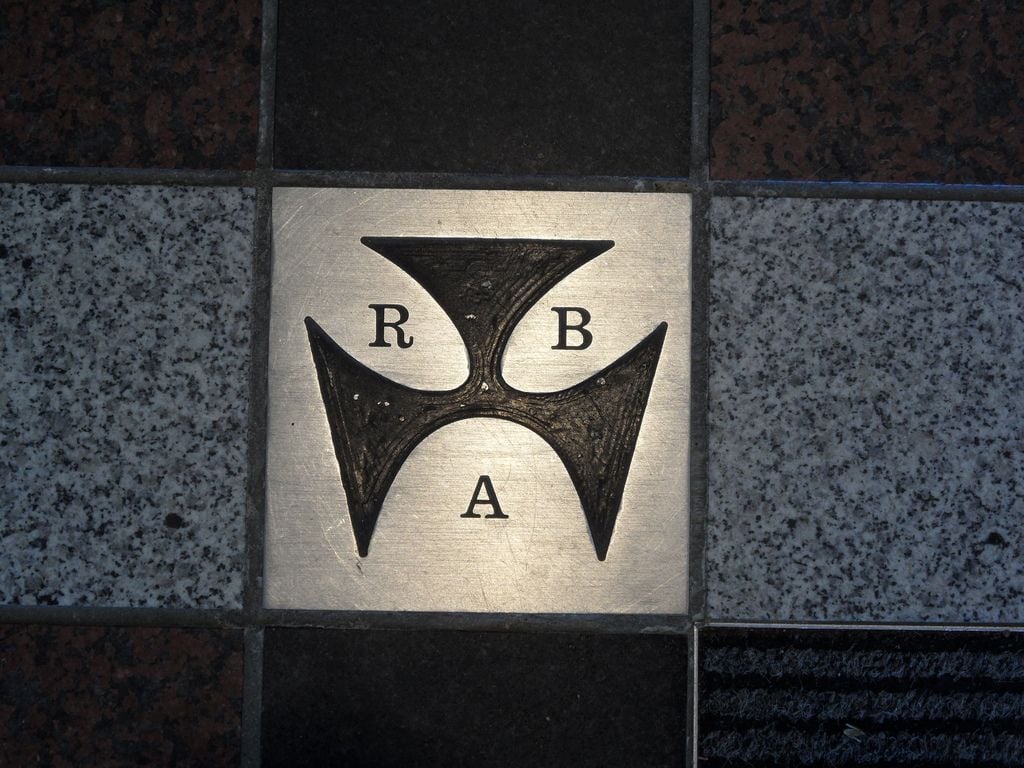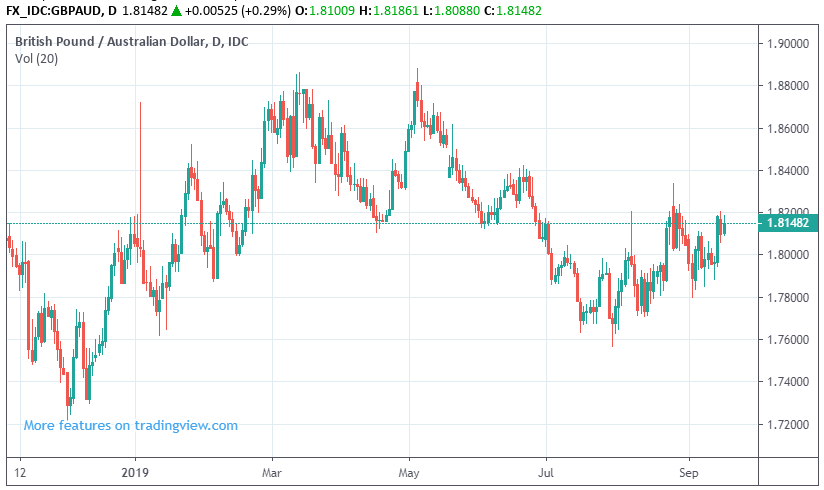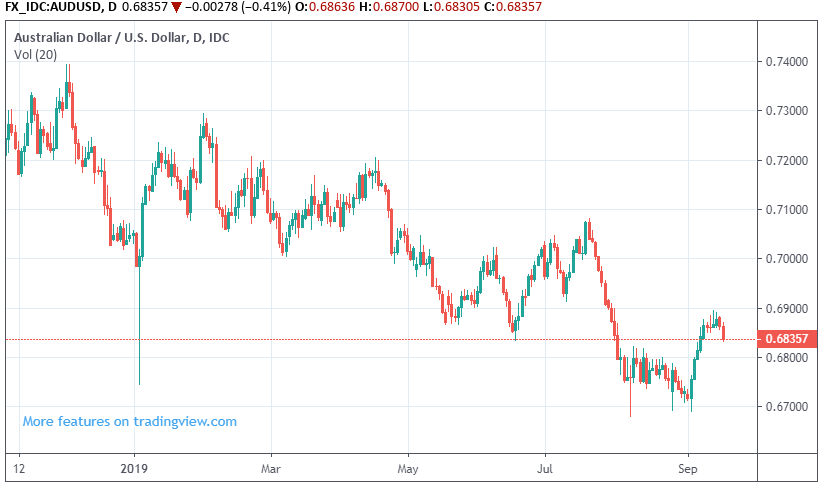The Australian Dollar is Under the Cosh as Downbeat RBA and Global Jitters Weigh
- Written by: James Skinner

Image © ArchivesACT, Reproduced under CC Licensing
- AUD bleeds lower on downbeat RBA and global market stress.
- RBA cut expected in November but October cannot be ruled out.
- As U.S.-China trade and oil price spike threaten global economy.
- But oil price rise not all bad for LNG-exporting Aussie economy.
- AUD/USD tipped by Commerzbank technical analyst as a buy.
The Australian Dollar was lower across the board Tuesday after a downbeat tone from the Reserve Bank of Australia (RBA) and jittery global backdrop saw investors dump the Antipodean currency, although technical analysts at Commerzbank are tipping it as a buy.
Australia's Dollar has been forced onto the back foot this week by a steep spike in oil prices that's raised fears about inflation and growth at a time when the global economy was already reeling from the latest escalation in the ongoing U.S.-China trade war.
Australia's commodity-backed Dollar is the most sensitive among major currencies to changes in the global growth outlook, leading overnight resilience in the oil price to be blamed for some of its weakness Tuesday.
"A significant spike in Australian petrol prices would pose a further threat to consumer spending and growth in Australia, adding to pressure on the RBA to ease further," says Dr Shane Oliver, chief economist at AMP Capital. "Prior to the attacks in Saudi Arabia, Australian capital city petrol prices were around $1.40 a litre. The rise in oil prices since then implies a rise to around $1.46."
Saudi Arabia, the world's second largest oil producer, has lost more than half its production capactity following a drone strike on a major oilfield that's also raised geopolitical tensions the world over, but especially in the Gulf. President Donald Trump claimed Monday Iran was behind the attack and said the U.S. is "locked and loaded" as well as willing to respond on behalf of Saudi Arabia.

Above: Brent Crude oil futures price shown at daily intervals.
"Overnight news saw Australian house prices down 7.4% y/y, while downbeat RBA Minutes confirmed market bias that the decision to leave rates on hold does not preclude further cuts. The market prices a cut in November, and some are wondering whether that move will come in October. Given weak Chinese data and higher oil prices, a re-test of lows in AUD/CAD at 0.8890, 2% below current levels, seems likely in due course," says Kit Juckes, chief FX strategist at Societe Generale.
The Reserve Bank of Australia also played a role in sending the Aussie lower Tuesday after minutes from the September policy meeting cast the bank in a more 'dovish' light than it had framed itself in a few weeks ago when announcing its decision to leave the cash rate at 1% this month.
The RBA said this month it will monitor developments "including in the labour market" closely over the coming months and cut rates again if necessary, when previously it had said only that it would "monitor developments in the labour market closely". The change suggests the bank will now take its lead from a broader array of indicators.
"The minutes had a generally dovish message. The RBA appear more concerned about the global back drop, noting slowing global trade, investment and growth," says Kim Mundy, a strategist at Commonwealth Bank of Australia. " The RBA continues to watch labour developments closely. It’s likely to take a long time to get the unemployment down to 4½% where the RBA would like to see it...CBA Economics expects the RBA to cut interest rates by 25bps in November and February."

Above: Pound-to-Australian-Dollar rate shown at daily intervals.
The RBA has cut Aussie interest rates twice this year in an effort to lift inflation back to the 2%-to-3% target band by stimulating the economy with lower borrowing costs. Those cuts have seen the Aussie's fall from grace among investors, who used to earn a yield premium from owning the Aussie instead of other currencies because of its typically higher interest rates, although the adverse impact of the RBA's policy is now being tempered by the threat of rate cuts in the U.S. and elsewhere.
Changes in rates are normally only made in response to movements in inflation, which is sensitive to GDP growth, but impact currencies because capital flows tend to move in the direction of the most advantageous or improving returns. Those flows tend to move in the direction of the most advantageous or improving returns, with a threat of lower rates normally seeing investors driven out of and deterred away from a currency.
"Lower iron ore futures prices also likely weighed on AUD in the Asia session," Mundy says. "Brent crude oil futures stabilised in the Asia session around $US68 per barrel...We do not think the bombing of the Saudi oil facility will keep AUD down for long. While the disruption to global oil supplies is a negative for global economic growth prospects and therefore will bear down on AUD, Australia is now a major exporter of gas."

Above: AUD/USD rate shown at daily intervals.
A sharp increase in the price of oil can lift inflation and suppress 'real GDP' growth because of its broad use in energy and manufactured products, which is why the 13% gain seen in Brent crude following the weekend drone strike in Saudi Arabia has been taken badly by markets and the Aussie.
However, CBA's Mundy notes a silver lining in the oil price story for Australia, which is that more expensive oil also means a higher liquefied natural gas (LNG) price because contract prices of the latter are tied to those of the former. Australia has become a major LNG exporter in recent years, so higher prices could improve the 'terms of trade', although any boost to economic growth would require shipment volumes to increase.
"Unexpected failure at .6678 on a daily chart closing basis would suggest the resumption of a down trend with the .6548 February 1999 high being in focus in this scenario. We think this unlikely to happen, though, and instead to see further upside near term," says Axel Rudolph, a technical analyst at Commerzbank. "Minor support is seen around the .6821 August 8 high and also at the August 21 high at .6799. Further down lies the .6736 August 14 low."
Rudolph has tipped the Aussie as a buy, telling Commerzbank institutional clients Tuesday to bet on a rise in the AUD/USD rate from 0.6825 to 0.6995 over the coming days and weeks. He also says he'll add to his 'position' if the market pulls back to 0.68 but walk away from it if prices reach 0.6730.
Time to move your money? Get 3-5% more currency than your bank would offer by using the services of foreign exchange specialists at RationalFX. A specialist broker can deliver you an exchange rate closer to the real market rate, thereby saving you substantial quantities of currency. Find out more here.
* Advertisement




